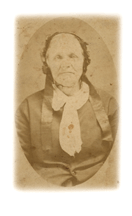She
made her mark
Give TCU's
cofounders credit where due, but without Rachel Lynn DeSpain, the University
might never have begun
By Carmen Goldthwaite '66 (MEd '72)

 Fifty-six-year-old
widow Rachel Lynn DeSpain climbed from the buckboard at Pecan Point and
set her first footprint on Mexican Texas soil in January of 1836. Fifty-six-year-old
widow Rachel Lynn DeSpain climbed from the buckboard at Pecan Point and
set her first footprint on Mexican Texas soil in January of 1836.
The mother of nine carried her grief in
silence "to the Lord." She had buried a daughter beside the trail, victim
of snakebite. Anticipation of joining her sister and another daughter
and son kept her headed west.
Another son -- the namesake of Rachel's father,
Benjamin Linn, a Revolutionary War scout, Indian fighter and longbow-hunter
turned preacher -- led the 156-member wagon train. Davy Crockett had pointed
them west from Alabama, but left early, fearful he would miss the fight
brewing between Texas and Mexico. Crockett was impatient with this "church
on horseback," a community of Christians descended from French Huguenots.
They did not travel on the Sabbath. Benjamin
Linn DeSpain, a preacher like his grandfather, practiced what Rachel had
instilled. They worshipped God on Sundays. Shaking dust from her apron,
Rachel suggested they "celebrate the Lord."
An oak stump draped with a buffalo hide
served for a pulpit. Setting up the large white tents, their homes for
winter, could wait. Hunters supplied game, and Rachel supervised meals
at the communal fire. After supper she would sit on a barrel, tap her
feet and clap to "happy tunes that make me feel good." Her warm, ringing
laughter thawed Texas' wet and bitter winter.
By March though, a chill pervaded. A rider
brought word of her son Randolph's death at the massacre at Goliad. By
late spring when lush green prairie grass along the Jonesborough bluff
rose "saddle skirt" high, the Texians had won at San Jacinto. Rachel buried
her grief. Her family turned south. Near Nacogdoches, she and her youngest,
Hettie, 12, moved into a log house.
The Republic of Texas granted Rachel her
headright, 1280 acres, in 1838. She made her "mark" on the deed with an
"X" because, she said, "Us girls didn't go to school; boys did during
winter. Our chores, cooking, cleaning, spinning went on all year."
She would be the last woman in the DeSpain
family left out of schooling. "We raise the little onesÉwe need to teach
them right," she said, and that meant reading, writing, ciphering, understanding
the "Lord's word so we know how to conduct our lives."
Candles in the window, lanterns glowing,
pine smoke curling from the chimney and a well-laden table beckoned family,
friends and sojourners, especially circuit-riding preachers. After dinner,
Hettie played the piano and sang while Rachel rocked in rhythm with the
hymns.
One day, a traveler on his way east stopped
in. He acquired office space and a room from Rachel and enjoyed her hospitality.
But it was Hettie's beauty, music and challenging mind that altered Joseph
Addison Clark's plans. He and Esther "Hettie" DeSpain married in 1842.
Enchanted by the good nature and laughter
in Rachel's home, his skeptic's view of religion was challenged by Rachel's
practices of kindness and acceptance. Joe Clark studied and was baptized,
attracted to the faith by his mother-in-law, her home a center for this
band of Christians.
When he and Hettie moved on, Rachel moved
with them. Over the years, she gathered more land. She received 960 acres,
Randolph's "bounty" for serving the Republic of Texas, and when a "good
deal" was offered, she sold and bought more, making her "mark" once more.
By the time Texas was a state, she owned parcels in Grayson, Fannin and
Hopkins counties. Impressed with Joe Clark and his "newspapering,"
Rachel loved and respected him. She wanted
Hettie to "keep up," so she tended their toddlers, Addison and Randolph,
while Hettie went east to seminary. Coming home the next year, Hettie
advertised in the newspaper as a "femme seule" (a woman declaring herself
legally responsible for her business matters), bought a piano and began
a seminary for girls in Palestine.
Years later, Randolph wrote of his family:
"blessed with a mother and a grandmotherÉ Esther and Rachel, and the unfeigned
faith that dwelt in themÉlearned that God is an ever-loving FatherÉthe
world and all things, even the commonplaceÉbelong to HimÉpeople must be
about the Father's work."
Horse trader, homemaker, independent woman
of strong and joyful faith, shy on education but not of common sense,
Rachel and her footprints led from the Red River to the Sabine and Trinity
rivers. Her legacy included love, joy, faith, a zeal for education and
land that would be brokered to begin a coed school in 1873.
Rachel did not live to hold her great grandson,
AddRan Clark, for whom TCU was first named -- AddRan Male and Female College.
Rachel's spunk fell to numerous DeSpains who pioneered, "preached and
taught."
All of the women descended from Rachel
have been educated well, although I am the first of the DeSpain line -- a
great, great, great granddaughter -- to attend TCU.

Carmen Goldthwaite is a Fort Worth freelance
writer. Her essay about Rachel Lynn DeSpain, she said, comes from "a
wealth of family stories from a strong oral tradition, diaries, family
Bibles and letters." Additionial
sources include: genealogical tracts of the DeSpain Log, Reminiscences
of Randolph Clark; Thank God We Made It, by Joseph L. Clark; Colby D.
Hall's A Fruitful Huguenot Strain through the DeSpain Family; Albert B.
Shankland's Benjamin Linn, Indian Fighter-Hunter-Scout-Preacher; H.L.
Waldrop's Wagons and Wit; Anglo-American Activities in Northeast Texas,
1803-1845 by Rex Strickland; Heroes of the Saddlebags by Jesse G. Smith;
land records from the original Red River County and Nacogdoches County
courthouses, military records and state archives.
Top
|



